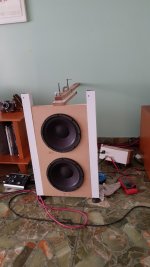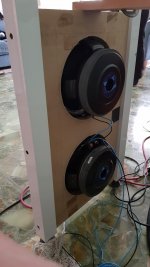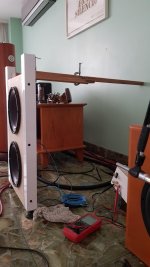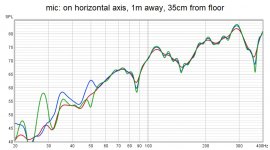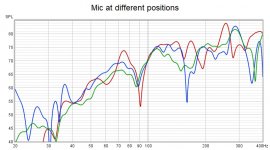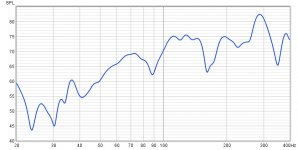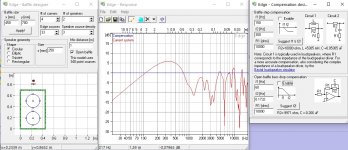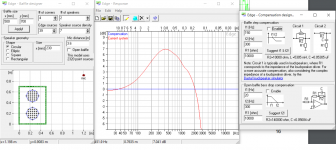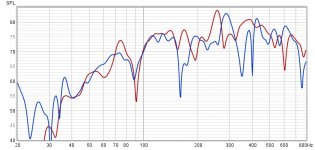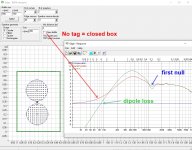I'm interested in exploring open baffle. Been reading a fair amount and wanted to gain experience so threw together something with materials I had around.
My system is 4-way active with digital xo and room correction, with sealed subs covering the bottom. They are ok to cross up to 80Hz, but I'd rather cross them lower, at 60Hz or less. I envision 8" mids and TPL-150 for tweeter (been reading StigErik's thread with TPL as dipole - and 21" woofers!!!).
I see most builds using 15" woofers, usually 2 of them (and no subs?). Most early work favored high Qts woofers, such as Eminence Alpha 15A. Martin King also liked the 15A, but he designed for passive crossovers. And later threads/posts seem to be ok with lower Qts woofers. So not sure what I'm looking for in a woofer.
Understanding if I need twin 15", or one, or 12", or 10" is kind of confusing so I assembled a quick OB with a couple Beyma 10G40 I have (Qts: 0.3, Xmax: 7mm, big motor). The MDF baffle is 32mm (2x16mm) and added the aluminum square tubes to gain baffle width, reaching 45cm. Placed it 90cm away from the wall, and took some measurements.
The room is pretty nasty: 5 x 4.85 x 2.4 meters, so basically square and height is almost half the length/width. This creates problems with bass response and I'm in the process of treating the room mostly with bass traps. Linkwitz recommends no treatment on the front wall...but mine is being processed, so I will have treated front wall and the speakers can be placed out up to one meter from the wall.
Pictures of the experimental setup
My system is 4-way active with digital xo and room correction, with sealed subs covering the bottom. They are ok to cross up to 80Hz, but I'd rather cross them lower, at 60Hz or less. I envision 8" mids and TPL-150 for tweeter (been reading StigErik's thread with TPL as dipole - and 21" woofers!!!).
I see most builds using 15" woofers, usually 2 of them (and no subs?). Most early work favored high Qts woofers, such as Eminence Alpha 15A. Martin King also liked the 15A, but he designed for passive crossovers. And later threads/posts seem to be ok with lower Qts woofers. So not sure what I'm looking for in a woofer.
Understanding if I need twin 15", or one, or 12", or 10" is kind of confusing so I assembled a quick OB with a couple Beyma 10G40 I have (Qts: 0.3, Xmax: 7mm, big motor). The MDF baffle is 32mm (2x16mm) and added the aluminum square tubes to gain baffle width, reaching 45cm. Placed it 90cm away from the wall, and took some measurements.
The room is pretty nasty: 5 x 4.85 x 2.4 meters, so basically square and height is almost half the length/width. This creates problems with bass response and I'm in the process of treating the room mostly with bass traps. Linkwitz recommends no treatment on the front wall...but mine is being processed, so I will have treated front wall and the speakers can be placed out up to one meter from the wall.
Pictures of the experimental setup
Attachments
Last edited by a moderator:
Sorry the pictures show up sided. Don't know how to adjust that.
Here are some measurements.
First I wondered about windowing...in OB we want the reflection...so tried FDW at 10, 15 and 20 cycles with the mic 1 meter away and 35cm from the floor (at the height in between the woofers), on horizontal axis. I decided to proceed with FDW: 15 cycles.
Next question was where to take the measurement? I measured:
I think the best option is #2, but would appreciate feedback.
Last picture is 1 meter away on-axis horizontally and at ear-height, smoothed to 1/12. I guess this could be usable from 40 to 300Hz, if I could address the troughs at 90 and 160Hz.
Here are some measurements.
First I wondered about windowing...in OB we want the reflection...so tried FDW at 10, 15 and 20 cycles with the mic 1 meter away and 35cm from the floor (at the height in between the woofers), on horizontal axis. I decided to proceed with FDW: 15 cycles.
Next question was where to take the measurement? I measured:
- 1 meter away on-axis horizontally and vertically (thus the mic was 35cm from the floor). The floor bounce must be an issue.
- 1 meter away on-axis horizontally and at ear-height.
- At listening position, at ear-height.
I think the best option is #2, but would appreciate feedback.
Last picture is 1 meter away on-axis horizontally and at ear-height, smoothed to 1/12. I guess this could be usable from 40 to 300Hz, if I could address the troughs at 90 and 160Hz.
Attachments
Would I get enough SPL at 40Hz, though?
Would I get enough SPL at 40Hz, though?
The Hypex amps have 400W for the woofers, and it's a 95 dB 1W and 1m sensitivity, but when REW white noise was measuring 75dB we see at 40Hz it was 55dB and the amp voltage was measuring 0.12V. What's the math to estimate max SPL with these amps and woofers?
If I take Beyma's published frequency response, it shows about 80dB at 80Hz at 1W and 1m. So 83dB for 2 drivers, leading to 107dB SPL at 1m at 250W (and 110dB when we add the other speaker). Here I would think the amps could drive them and apply a lot of room correction higher up, but the 55dB above has me thinking otherwise.
Would love to hear from experienced users!
Would I get enough SPL at 40Hz, though?
The Hypex amps have 400W for the woofers, and it's a 95 dB 1W and 1m sensitivity, but when REW white noise was measuring 75dB we see at 40Hz it was 55dB and the amp voltage was measuring 0.12V. What's the math to estimate max SPL with these amps and woofers?
If I take Beyma's published frequency response, it shows about 80dB at 80Hz at 1W and 1m. So 83dB for 2 drivers, leading to 107dB SPL at 1m at 250W (and 110dB when we add the other speaker). Here I would think the amps could drive them and apply a lot of room correction higher up, but the 55dB above has me thinking otherwise.
Would love to hear from experienced users!
If you care to rotate the images, viewers like myself would appreciate more of the work(time and effort) you put in. if you spend 5sec to rotate each image before uploading them otherwise we(each one of us) will have to download all the images then rotate them ourselves and that will take us more time.
Last edited by a moderator:
It was a hidden setting. - What Is EXIF Data, and How Can I Remove It From My Photos?Sorry the pictures show up sided. Don't know how to adjust that.
Measuring bass indoors is difficult, yes.
Your measurements show many reflections and room modes. I can't be sure where first dipole null is, simuated freefied response helps, I use The Edge for that.
Remember that you need 12dB/oct equalization below peak. Remember to check distortion and excursion below 50 Hz after eq.
Your measurements show many reflections and room modes. I can't be sure where first dipole null is, simuated freefied response helps, I use The Edge for that.
Remember that you need 12dB/oct equalization below peak. Remember to check distortion and excursion below 50 Hz after eq.
You suggest 75dB and my first rection was to guess 73dB (between 100-400Hz). When the higher frequencies are using 1W, 40Hz would need between 65-100W to be at the same level.95 dB 1W and 1m sensitivity, .... What's the math to estimate max SPL with these amps and woofers?
It was a hidden setting. - What Is EXIF Data, and How Can I Remove It From My Photos?
Allen,
Thank you so much for taking the time to post this AND to make the corrections!!
I read the article and it's not obvious to me what you did: did you dowload the pictures to your computer, edited exif data, and reloaded? When I open a picture on my android phone I can't see a setting that tells the website to rotate or not - I'd rather not downoad the picture from phone onto computer before loading to DIYaudio.
Thnks much again!
What happened to mtm setup?
I ran into issues with my main soundcard which I'm still troubleshooting. So I'm using a secondary card that allows to measure one channel at a time with REW.
The inent for MTM with those drivers was to achieve a sensitivity suitable for midrange driven by 2A3, and I am also revisiting that desire now.
Nevertheless this OB could easily end up with said MTM in OB, so I am far from having ditched the idea. In fact StigErik used the TPL-150 OB crossing over at 1550Hz, which seems a feasible xo frequency for the MTM.
But also if I use a 25Wpc amp for midrange I might be better off with one midrange driver. Experimentation will tell.
Your measurements show many reflections and room modes. I can't be sure where first dipole null is, simuated freefied response helps, I use The Edge for that.
Initial shot at The Edge attached. Please note: mic at ear-height and 1m distance, on the right panel I have disabled baffle step compensation and open baffle bass drop compensation - as I don't know what they mean
Is the dipole null the one at 1300-1400Hz? How should I use that info?
Remember that you need 12dB/oct equalization below peak. Remember to check distortion and excursion below 50 Hz after eq.
I use Acourate to generate my digital filters. The process is to measure response, set a target curve below the measured response, then the filter reduces response down to the target curve. Envision a horizontal line from the 50Hz response, and everything else will be brought to that. So that would equate to the equalization you refer to, correct?
And then what you are saying is I should set up the xo and filters, run the system and measure distortion at 50Hz while running with that eq applied. Did I get that right?
Attachments
your Edge sim is 30 deg upwars off-axis, and open baffle (tag in box)
You have those list on the edge of baffle, they add width so I used 500mm width, on-axis mic at 2m and the sim is below. Dipole null at roughly 1200Hz (and closed box has same baffle diffraction null but not so deep)
Yes baffle compensation must be 6dB/oct and in my sim we can see how dipole loss continues 6dB/oct below 130Hz. Baffle boost 2-3dB happens around 1kHz.
To make crossovers work as intended, both low- and highpassed "ways" must have straight response at least one octave past the crossover point! (unless one uses brickwall filters) acourate can do that, but it must be done for each "way" individually!
More about designing open baffle/dipole multiways
Dipolplus - Alles über offene Schallwände - go to Downloads and download a pdf in english
Hybrid Design
In your case distortion or power requirements should not be a problem above 50Hz
You have those list on the edge of baffle, they add width so I used 500mm width, on-axis mic at 2m and the sim is below. Dipole null at roughly 1200Hz (and closed box has same baffle diffraction null but not so deep)
Yes baffle compensation must be 6dB/oct and in my sim we can see how dipole loss continues 6dB/oct below 130Hz. Baffle boost 2-3dB happens around 1kHz.
To make crossovers work as intended, both low- and highpassed "ways" must have straight response at least one octave past the crossover point! (unless one uses brickwall filters) acourate can do that, but it must be done for each "way" individually!
More about designing open baffle/dipole multiways
Dipolplus - Alles über offene Schallwände - go to Downloads and download a pdf in english
Hybrid Design
In your case distortion or power requirements should not be a problem above 50Hz
Rudolf,
I can't thank you enough for writing that paper and pointing me to it. BIG THANK YOU!!!!
The content is still sinking in. I haven't yet looked into the hybrid design as I'm taking in all the new info in the paper.
One big takeaway: 30 degree listening, like in an equilateral triangle is a problem. That is what I have now. So I should decide if this is a non-starter and I should ditch the idea.
50cm-wide speakers would have their centers 2.6m apart. While my listening position is at an equilateral triangle, I could also move to listening on the couch at the back wall which would have me seating at 21 degrees off-axis from each speaker...but my head would be 20-30cm away from a back wall diffusor...
Time to drop the idea?
I think you intended to include a simulation that didn't come through. Not sure why you added width to the baffle, but I did the same on the new sim. Mic distance is 3.6m, which is what it would be if I were on the back couch. I kept mic height where my ears would be, but not sure if I should.
I added a graph showing response up to 800Hz. Not sure I can tell if there is straight response with everything going on.
I can't thank you enough for writing that paper and pointing me to it. BIG THANK YOU!!!!
The content is still sinking in. I haven't yet looked into the hybrid design as I'm taking in all the new info in the paper.
One big takeaway: 30 degree listening, like in an equilateral triangle is a problem. That is what I have now. So I should decide if this is a non-starter and I should ditch the idea.
50cm-wide speakers would have their centers 2.6m apart. While my listening position is at an equilateral triangle, I could also move to listening on the couch at the back wall which would have me seating at 21 degrees off-axis from each speaker...but my head would be 20-30cm away from a back wall diffusor...
Time to drop the idea?
your Edge sim is 30 deg upwars off-axis, and open baffle (tag in box)
You have those list on the edge of baffle, they add width so I used 500mm width, on-axis mic at 2m and the sim is below. Dipole null at roughly 1200Hz (and closed box has same baffle diffraction null but not so deep)
I think you intended to include a simulation that didn't come through. Not sure why you added width to the baffle, but I did the same on the new sim. Mic distance is 3.6m, which is what it would be if I were on the back couch. I kept mic height where my ears would be, but not sure if I should.
Yes baffle compensation must be 6dB/oct and in my sim we can see how dipole loss continues 6dB/oct below 130Hz. Baffle boost 2-3dB happens around 1kHz.
To make crossovers work as intended, both low- and highpassed "ways" must have straight response at least one octave past the crossover point! (unless one uses brickwall filters) acourate can do that, but it must be done for each "way" individually!
I added a graph showing response up to 800Hz. Not sure I can tell if there is straight response with everything going on.
Attachments
Yes. I don't have the answer but if it were me, I'd try taking the photo in landscape to see if there's a change. Some report that if you edit/crop a photo it removes the info. I have found that while some editing software always removes it, some always puts it back so if I strip the data, but final rotate it using the wrong software it goes back to the wrong orientation.did you dowload the pictures to your computer, edited
Sorry attachment forgotten
Thank you!
In my first Edge sim I had "open baffle" tag on, but the second time I neglected it.
So I want to stay in the linear area for about two octaves. So maybe I shoot for 50 - 200Hz, and see later if I can raise it to 300Hz. I guess I should look into the 8" midrange now, probably baffle-less in the midrange and tweeter, with hanging drivers.
The most burning question is the suitability of my room for OB/dipoles, though. What do you think? I took away from the paper that an equilateral triangle with speakers and listening position is not suitable for this kind of speakers.
re-visit the past
May I refer you to a statement of fact, which at one time you fund enlightening:
"Design goal: 80Hz - 400Hz in a sealed alignment.
A speaker + box_alignment that naturally meets the 80Hz - 400Hz design goal and uses equalization mainly for room effects will normally have better sound than a speaker+box which needs extensive equalization just to be flat over the main BW."
Beyma 10G40 in SEALED box for 80-500Hz? Or Eminence 4012HO?
And finally, to be brutally honest here (but in hopes of ultimately helping you) judging by the pictures of your room, it must be horrible sounding. Thus, it's not your speakers per say, it's that awful room.
May I refer you to a statement of fact, which at one time you fund enlightening:
"Design goal: 80Hz - 400Hz in a sealed alignment.
A speaker + box_alignment that naturally meets the 80Hz - 400Hz design goal and uses equalization mainly for room effects will normally have better sound than a speaker+box which needs extensive equalization just to be flat over the main BW."
Beyma 10G40 in SEALED box for 80-500Hz? Or Eminence 4012HO?
And finally, to be brutally honest here (but in hopes of ultimately helping you) judging by the pictures of your room, it must be horrible sounding. Thus, it's not your speakers per say, it's that awful room.
I have a 3 way plus sub OB system (a single 12" woofer with a 12" pro-sound coaxial for mid+tweet). So somewhat similar to what you are looking to build. My experience is that a single 12" woofer is sufficient if you cross over to the sub around 60Hz. My woofer is in a 14" wide by 8" deep "U baffle" and has 8mm of Xmax. I sometimes play it loud enough that it disturbs my wife upstairs and I do not hear any distress from the woofer. SO I hope that answers your original question.
Scott may be right about your room. The hard floor, in particular, strikes me as bad. A carpet would help as would some wall and ceiling treatment.
The rest of this post is derived from my experience and I will note that others may have different experiences: As to where to measure from; that, IMHO, is the hardest part of OB design. If you measure very close it's not representative of what the system's power response is. The OB interacts with the room so much that outdoor measurements are, IMHO, close to useless. So after much messing around I have settled on measuring at the listening position (and the general vicinity adding some averaging). Compared to other speakers I've had in the room, unfiltered OB measurements look not so great, but sound very nice. So if you are obsessed with measurements maybe OB won't be for you as you'll never get rid of all of the wiggles in your curves (not without a lot of smoothing).
Scott may be right about your room. The hard floor, in particular, strikes me as bad. A carpet would help as would some wall and ceiling treatment.
The rest of this post is derived from my experience and I will note that others may have different experiences: As to where to measure from; that, IMHO, is the hardest part of OB design. If you measure very close it's not representative of what the system's power response is. The OB interacts with the room so much that outdoor measurements are, IMHO, close to useless. So after much messing around I have settled on measuring at the listening position (and the general vicinity adding some averaging). Compared to other speakers I've had in the room, unfiltered OB measurements look not so great, but sound very nice. So if you are obsessed with measurements maybe OB won't be for you as you'll never get rid of all of the wiggles in your curves (not without a lot of smoothing).
The woofers mounted low combined with the hard surface take the floor out of the equation (at low frequencies), which is the goal at the sides for a dipole, only the floor does it arguably better.hweb said:The hard floor
- Home
- Loudspeakers
- Multi-Way
- 3-way open baffle plus subs
